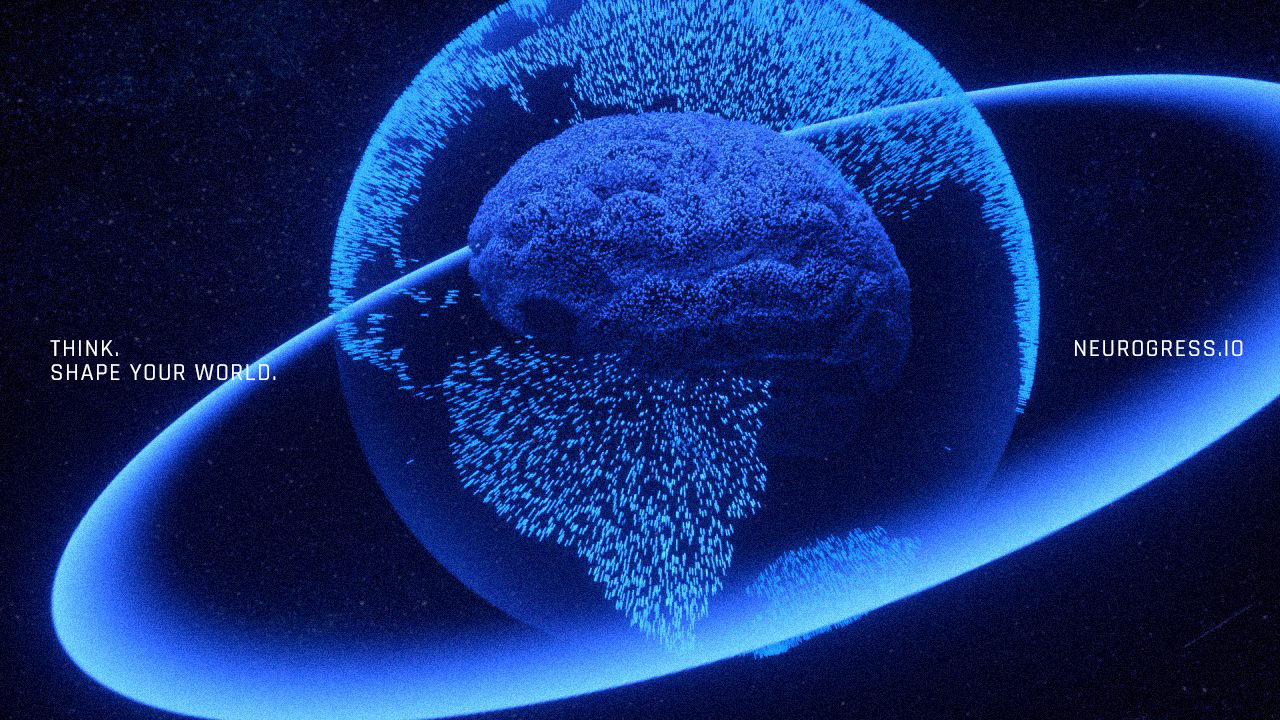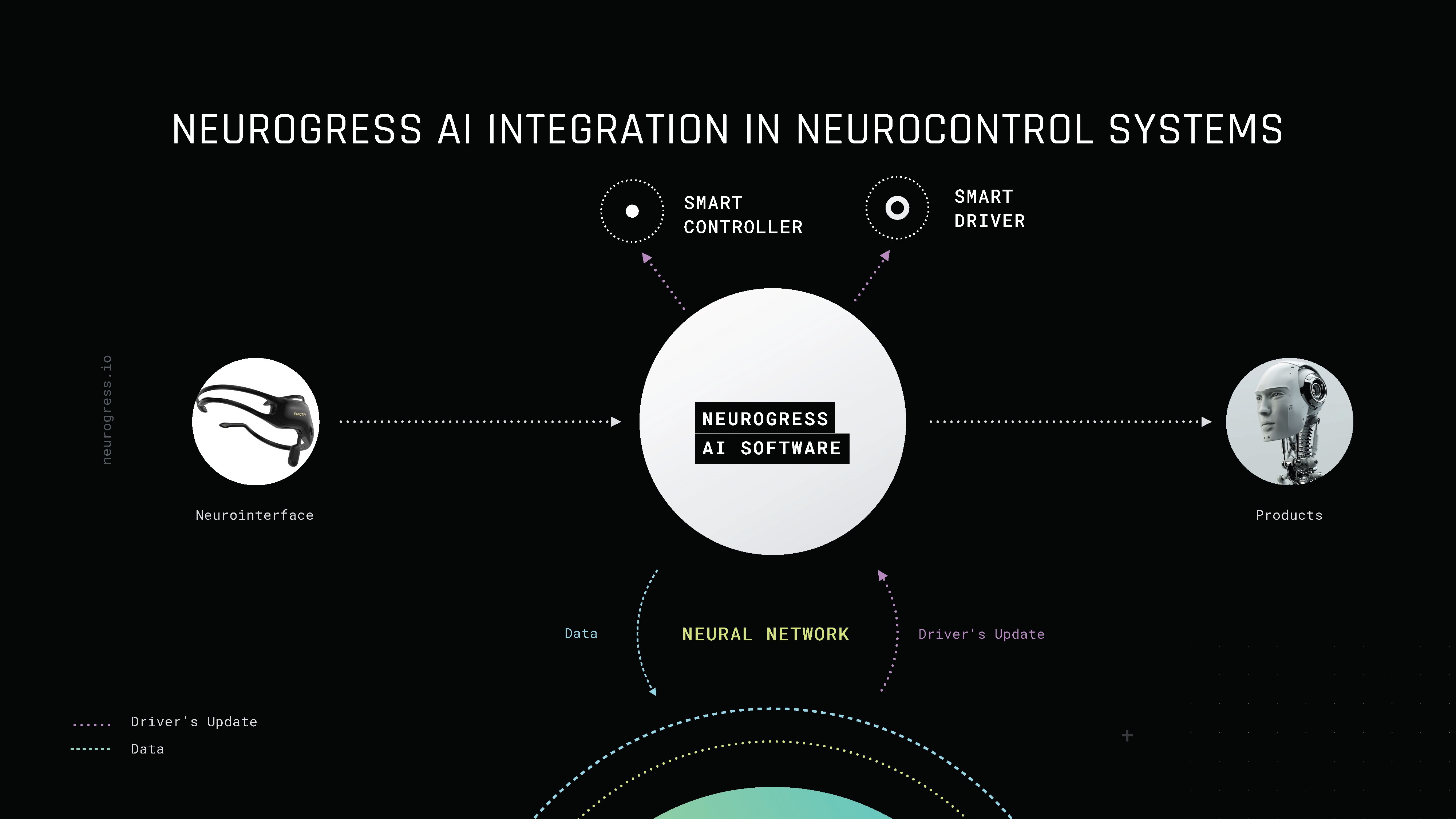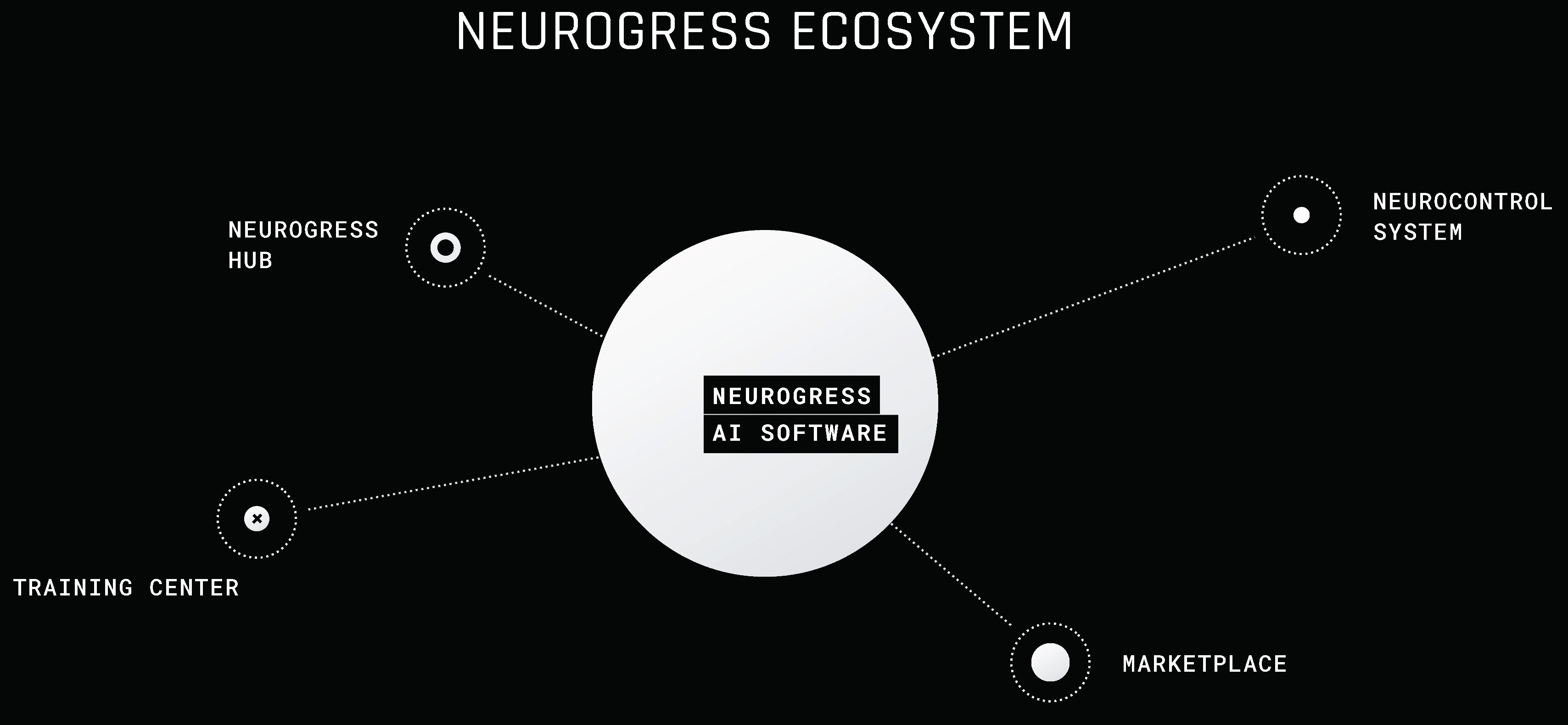Neurogress: a platform of neurocontrol systems from Blue Brain project participants

The past 2017 was a landmark for various startups who raised funds for their development through the ICO. We have witnessed the creation of a virtually new industry from the ideas of a handful of enthusiasts. Of course, there were both white and black sides of raising funds.
Today I want to tell Habr’s readers about one project - Neurogress , which was recently announced by the team that worked in the Blue Brain Project. In short, the essence of this project is to create an ecosystem in which it would be possible to develop software for the neurocontrol of various devices (robotic prostheses, drones, items from the Internet of Things, IoT, and so on), as well create the devices themselves and train the algorithms for the development of the Artificial Intelligence (AI) system of neurocontrol (and even receive money, tokens for this).
First of all, it will be of interest to those who are engaged in the field of artificial intelligence, pattern recognition and machine learning. On the other hand, everyone can support a project that will open pre-TGE (Token Generation Event) the other day.
Intro
According to White Paper (WP), published here , each of us is one big neural interface between our brain, which cognizes and exploits reality, and often an aggressive environment. Over the past thousand years, we have invented many pseudo-interfaces that help adapt our mortal body, but for which we need arms, legs, fingers.

The evolution of interfaces: from ancient times to the present. Source: Neurogress presentation
. Now imagine that at one point in time such a “conductor” of the will of the brain will not (illness, accident, accident, and so on), a person is limited in their actions and capabilities. In this case, replacement is necessary and it is desirable that it be controlled directly from the brain.

Robotic prosthesis. Source: WP Neurogress
Startup Neurogress aims to help develop such neurocontrol systems that could directly transmit signals from the brain to robotic devices (for example, the same prostheses). The basis of the team is made up of participants in another high-profile brain-conquering project - the Blue Brain Project (I wrote about it here and answered questions here ). Therefore, the project is based in the city of Geneva, Switzerland, where the headquarters of the Blue Brain Project is located. The team decided to apply their accumulated knowledge and experience in the development of a neurocontrol system based on artificial intelligence and machine learning.
The main objective of the project is the development of software for the neurocontrol of various electronics, devices and machines. Neurocontrol in this project refers to patterns of brain activity (brain waves) that are collected using the neural interface and analyzed by machine learning and AI, and then transmitted in the form of commands to a specific device. It is important to note that the project is aimed specifically at working with non-invasive signal reading devices, which should greatly simplify the implementation of technologies, but more on that below.
An inquisitive reader will ask: so what about the mechanical / bionic limb and its direct interaction with the brain?
At the initial stage of the project, artificial limbs and mini-robots will be a " model system"to test solutions. However, the team plans to adapt its software for other areas: control of drones, cars and robots in production, new smart home systems and many other devices that could and, most importantly, should be controlled directly from the brain.
But let's understand with everything in order!
Briefly about the neural interfaces and capabilities of neurocontrol systems
The idea of controlling technology using the power of thought has repeatedly appeared on the pages of science fiction and in games. Most likely, many remember how the insidious Yuri tried to seize power in the Red Alert 2 universe precisely with the help of a peculiar neural interface and psi waves.

From the Internet
In reality, of course, everything is not so simple as in books and games. The best minds of mankind are struggling to enable us to control reality through the power of thought. The brain is a very large computer in which electrical discharges run back and forth constantly (as long as he, the brain, is alive), and, therefore, they can be counted and analyzed, revealing a “gentle” signal of brain activity among extraneous noise. Actually, this simple, at first glance, idea makes up the foundation of all neural interfaces and control systems based on them.
Neurocontrol technology can be divided into several groups:
- Invasive. Electrodes must be implanted in the human body, most often in the brain. The main drawback of this type of technology, despite the significant results achieved, is interference in the internal environment of the body. As a result, the high cost of error and a decrease in sensitivity over time (the body is rebuilt and “protected” from interference).
- Myosensors. Electrodes are located on the skin of a person and read pulses passing through the muscle fibers. Perhaps the most famous example, thanks to Stephen Hawking. However, this type has a significant delay: the signal from the brain through the central nervous system must reach the muscles and only then it will be read and interpreted, and, therefore, the delay is several seconds.
- Non-invasive Based on various techniques for recording the electrical activity of the brain using external devices. The main disadvantage is the non-specificity of the information received and its extremely difficult interpretation, which requires a scrupulous approach, the development of large amounts of data and the isolation of statistical information that is needed from them. In more detail about the shortcomings of non-invasive methods and the advantages of applying AI to this problem are described in WP .
The Neurogress team, which plans to create such a system of data collection, processing and application, is aimed at the latter type. It is non-invasive technology that will create a product for the mass market, which entails a number of positive aspects. For example, mass use will allow (i) attract more programmers to develop third-party applications, (ii) identify problems in algorithms and training models as soon as possible (below I will give an example of how it is planned to implement this through NRG coins), (iii) reduce the cost of using software and , ultimately, devices with neurocontrol systems.

An example of a device for non-invasive reading of brain activity. Source: WP Neurogress
Neurogress Solution
The Neurogress team focuses on developing algorithms and machine learning to recognize patterns of brain electrical activity and correlate them with limb motility. Since AI approaches will be applied, the final system will be tailored to each specific customer with its features. It is planned that the training process will take only 2-3 weeks to control a robotic arm instead of 4-18 months for existing solutions on the markets.
Here is a video demonstrating the capabilities of neurocontrol systems after some training:
The video shows that the system works with a delay. One of the goals of the project is to bring this delay to at least 0.5 seconds, and at best to 0.05 s. In this case, the robotic limb itself can have up to 28 moving parts. And the cost of the product itself will be reduced from 2 to 5 times precisely due to a simpler and easier interface between the brain and the device.

The block diagram of the system. Source: Neurogress presentation.
How are you supposed to collect and process data?
- A non-invasive brain activity sensor (neuro interface) reads the electrical activity of neurons
- Signals are recognized by frequency. There are 8 types of main signals of brain activity in total, combinations between which can be implemented for neurocontrol devices
- Approximately 10% of the data remains unchanged, while 90% will be used to train the system with various patterns.
- The results of multiple workouts are compared and the best solution is remembered by the system and then played
- As soon as the signal is recognized and classified, the command is sent to the device to perform a specific action
Thus, the software from the Neurogress team is a kind of intermediary connecting the neural interface as such and robotic systems that the brain can now directly control. At the same time, the constantly accumulated data array allows you to increase accuracy and regularly update and modify algorithms and drivers for devices that are under neurocontrol. As presented in the two diagrams below.

Integration of AI into neurocontrol systems. Source: Neurogress presentation, also available at WP Neurogress Inside the Neurogress

AI Learning Ecosystem. Big brother no longer watches, but helps to adapt to new challenges. Source: Neurogress presentation, also available at WP Neurogress
Blockchain and NRG coins as the basis of the project
One of the features of the platform and ecosystem being created is the presence of its own cryptocurrency - NRG (for now, these are tokens, but by mid-2019, that is, a year after TGE, tokens will be converted to coins, a full-fledged cryptocurrency). It will not only be used to make purchases within the ecosystem and pay developers (as in the figure below), but it can be “mined”. Mining refers to the physical use of devices with Neurogress solutions and AI training, as soon as successful recognition of brain signals with sufficient reliability is achieved, a coin is emitted.

Schematic motion of NRG coins in the Neurogress ecosystem. Source: Neurogress presentation, also available at WP Neurogress
Why blockchain? Modern giant companies such as Microsoft, Google, Facebook and many others " monitor " users, collect statistics and use it to improve and promote their products. When it comes to how often you use mail (gmail or outlook) or what you eat for breakfast (Instagram aka Facebook, Pinterest, Google Photos), then there’s nothing to worry about being “ spied ” on you. This is an inevitable consequence of technology development. However, when it comes to typical patterns of your brain activity, it is unlikely that users will voluntarily agree to transfer this data to any particular company.
The Neurogress approach is that the development of AI is decentralized, each only has access to its own small piece of data, which it processes. At the same time, protection from monopolism over statistical data is implemented.
A savvy user will ask: there are a ton of popular cryptocurrencies such as ether (ETH). Why not base them?
Indeed, at the initial stage of NRG tokens are tied to the air, however, Neurogress plans to acquire its own currency in order to increase the speed of transactions and lay down its own principles for mining NRG coins. The latter will depend solely on how effectively Neurogress products are used.

NRG coins and their use. Source: Neurogress Presentation
Ecosystem Neurogress
As already mentioned, the central part of the ecosystem will be the AI and machine learning platform (AI Software in the diagram below), which will collect data, process it and turn it into signals for specific devices.

Key elements of the Neurogress ecosystem. Source: Neurogress presentation, also available in WP Neurogress.
It will also include the following modules:
- Training center Neurogress. It is a virtual training camp designed to help future customers hone their facility management skills through neural interfaces. The main role of such a center is to ensure the safe, stable and confident use of Neurogress software, be it a drone, a mechanical arm or a robot. Training will be carried out remotely using virtual reality technology.
- Neurogress Hub. This platform is necessary to ensure communication between individual developers and project participants. Here, IT specialists and technology enthusiasts will exchange experience, communicate and develop joint projects. In addition, it is planned that the Hub will organize offline meetings (meet-up in certain areas of the company). Thus, the Hub will support development for as many devices as possible.
- Development market. It is the development market that will become the place where it will be possible to realize the lion's share of NRG coins for the purchase of ready-made software, compatible hardware, algorithms and various services. Around each product, a manufacturing company, a community of developers and partners will be grouped. Equipment manufacturers, even if they use only part of Neurogress solutions, will have full support from Neurogress (algorithms, user interaction with aka UX research, research and development, and so on). In addition, all products offered and released will be fully categorized and easily searchable.
Project stages
At the initial, preparatory stage, Neurogress developed a beta version of neurocontrol software and tested it on a simple prosthetic arm and mini-robots, while collecting important statistical information.
At the next stage, which will last until the summer of 2018, the team plans to complete software testing cycles and present a beta version of prosthetic control for 8 movements. Already in May, after the completion of the initial round of TGE, a test version of the robotic arm and drone control software will be released. Upon completion, TGE Neurogress plans to introduce its own API and put the source code in the public domain.

The main stages of project financing and the amount of work performed with the collected funds. Source: Neurogress presentation, also available at WP Neurogress
Further - more, in 2019 an online platform will be launched, which will include several elements for the interaction of customers, third-party programmers and software developers (more on this below), integration with IoT infrastructure, the beginning of the full-fledged development of mechanotronic hand prostheses with an eye to statistics collected.
Business model
Potential competitors for Neurogress in the emerging device neurocontrol market are: the American company Cyber Kinetic, the Australian Immotio, and the Russian startup from Skolkovo. At the moment, there is no accurate forecast and dry numbers for this market, however, the authors of NeuroNet suggest that various neurotechnologies will collect around $ 1 trillion in total by 2035. At the same time, growth will be mainly provided due to the massive demand for augmentation (artificial ears, eyes, limbs), as well as neuromorphic computers and neural interfaces for controlling home devices.
In the short term, the Neurogress team plans monetization paths related to development in the following areas:
- Software for neurocontrol systems
- Joint projects on the integration of neural interfaces for controlling mechanized limbs with industry leaders
- Creation of neuro-manageable humanoid robots and industrial robots together with leading manufacturers
- Creation and development of a market for software developers and engineers
- Creation and development of a market for training algorithms
- Neurogress Ecosystem Development
In addition, the company plans to create a market where users can create and sell devices for the disabled, which will be based on software from Neurogress. Monetization will be carried out due to deductions for the use of such software. At the same time, depending on the amount collected during the issue of tokens, the company will post in open access a code that each developer can build for himself.
To support user enthusiasm, the company will create a Neurogress ecosystem fund, in which 10% of the company's profit will be invested. Fund money will be used to support developers and for educational purposes. Monetization is achieved through the sale of training packages and tickets for seminars.
The main markets where Neurogress plans to enter (specific numbers for each market are given inWP ):
- Prosthetics
- Robotic systems
- Internet of things
- Drones and unmanned aerial vehicles
- Virtual Reality (AR / MR / VR)
- Smart Home Systems
Instead of a conclusion
Startup Neurogress sets itself extremely ambitious tasks that scientists have tried to solve for many decades, but only today with the development of AI systems and machine learning can this be realized in code and hardware. Plus, the development team will not have much time to “think”. The development schedule is quite tight and will not be delayed.
Very soon, on February 10, 2018, a pre-TGE company will start, during which it is planned to collect about 15.7k ETH to fully finance the project. It will last until March 25th. The main round, however, will begin on May 1, 2018 and will last 2 months until the end of June. For this round, it is planned to attract another 42.2k ETH. In total, the team expects to gain 58.5k ETH for the development of the project.
Additional information: project site ,White-Paper , official telegram chat , media support is provided through Facebook , Twitter , Medium and BitCoinTalk ANN .
The project also has a Bounty Campaign incentive program with support for participants via telegrams .
PS: as in the case of the Blue Brain Project, Habré readers can ask all interesting questions in the comments that will be transmitted to the Neurogress team and to which they will try to give comprehensive answers.
PPS: Do not forget to subscribe to the blog and look at my Telegram channel : it’s not difficult for you - I am pleased! And yes, please write about the shortcomings noted in the text in the PM.
